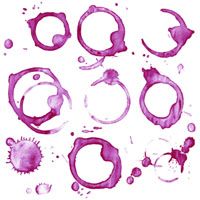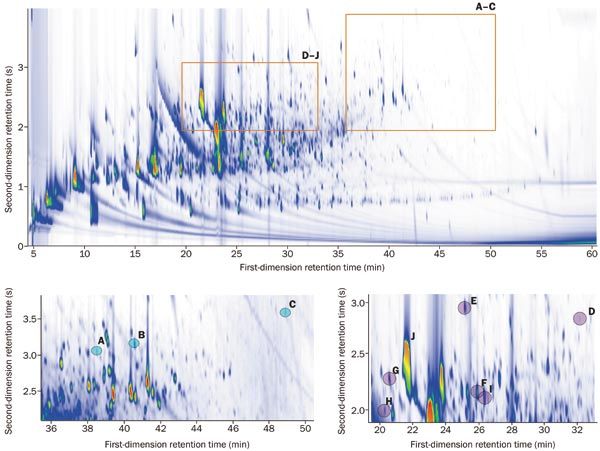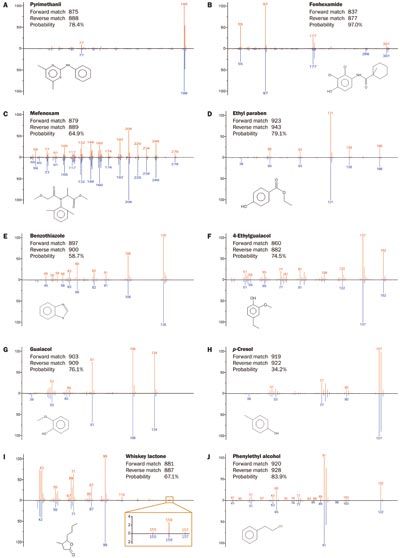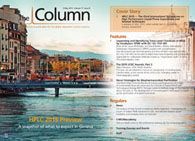Separating and Identifying Trace-Level Chemicals in Wine by Headspace SPME with GC×GC–TOF MS
The Column
Solid-phase microextraction (SPME) coupled with comprehensive two-dimensional gas chromatography and time-of-flight mass spectrometry (GC×GC–TOF-MS) can be used to detect trace-level fungicides and compounds responsible for undesirable attributes known as “organoleptic faults” in wine. Of particular interest is the analysis of trace-level fungicides, which are difficult to detect using conventional quadrupole GC–MS techniques without resorting to selected ion monitoring mode.
Solid-phase microextraction (SPME) coupled with comprehensive two-dimensional gas chromatography and time-of-flight mass spectrometry (GC×GC–TOF-MS) can be used to detect trace-level fungicides and compounds responsible for undesirable attributes known as “organoleptic faults” in wine. Of particular interest is the analysis of trace-level fungicides, which are difficult to detect using conventional quadrupole GC–MS techniques without resorting to selected ion monitoring mode.
Photo Credit: itchySan/Getty Images

Vineyards use fungicides to control various fungal diseases - such as moulds and mildews - to maintain crop quality. Despite regulations prohibiting fungicide application in the period before harvest, fungicides can (and do) end up in the wine, necessitating continued monitoring to minimize any potential risk to human health. However, fungicides only represent a relatively small number of the many compounds that are of interest to a wine analyst. Of more interest are compounds that result in undesirable smell, taste, or aroma characteristics (so-called “organoleptic faults”), especially when the presence of trace levels has a disproportionate impact upon the characteristics of the final product.
Currently, fungicides and compounds giving rise to organoleptic faults are screened by headspace solid-phase microâextraction (SPME) with gas chromatography (GC) and quadrupole mass spectrometry (MS). The major drawback of this technique is the poor sensitivity in full-scan mode, which is a problem when detecting trace-level components in complex wine matrices. This issue can be addressed by using the quadrupole instrument in selected ion monitoring (SIM) mode, but in this mode it is not possible to detect unknowns.
Comprehensive two-dimensional gas chromatography coupled with time-of-flight mass spectrometry (GC×GC–TOF-MS) is an ideal choice for such analyses, because the enhanced peak capacity afforded by the coupling of two columns of different selectivity means that more information on sample composition can be obtained.
This article describes how the enhanced separation offered by GC×GC can be coupled with highly sensitive TOF-MS to enable the screening of wine for trace-level fungicides, as well as compounds giving rise to organoleptic faults.
Experimental
Sample Preparation: SPME was used to extract target analytes from samples of Chianti wine. Each 20 mL headspace sample vial contained wine (1 mL), water (4 mL), sodium chloride (2 g), and an internal standard (40 µL) containing internal standards from a range of chemical classes (ethyl acetate-d8, ethyl hexanoate-d11, butanol-d10, 5-methylhexanol, acetic acid-d3, hexanoic acid-d11, and 1,3-dimethylphenol). Sample vials were sealed and heated at 60 °C for 2 min. The headspace was then extracted, with agitation, at 60 °C for 15 min using a DVB/carboxen/PDMS fibre (Supelco) (50/30 µm). The SPME fibre was conditioned at 275 °C for 30 min between samples.
GC Set-Up: Instrument: 7890A (Agilent Technologies) equipped with a ZX1 thermal modulator (Zoex, Inc.). Carrier gas: Helium. Flow: 1 mL/min. Mode: Splitless. Inlet temperature: 275°C. 2D column set: 1st dimension: 30 m × 0.25 mm, 0.25-µm, BPX5 (SGE Analytical Science). 2nd dimension: 2.00 m × 0.1 mm, 0.1-µm, BPX50 (SGE Analytical Science). Modulator delay loop: As for second dimension (1.00 m). Temperature programme: Main oven: 40 °C (1.0 min), 5 °C/min to 315 °C (5 min). Secondary oven: No offset. Hot jet: 165 °C (2.0 min), 3.5 °C/min to 400 °C (hold time matched to total run time). Modulation period: 4.0 s. Hot-jet pulse 350 ms. Total run time: 61 min.
TOF-MS: Instrument: BenchTOF-HD (Markes International). Filament voltage: 1.9 V. Ion source: 250 °C. Transfer line: 300 °C. Mass range: m/z 40–500. Data rate: 50 Hz (200 spectral accumulations per data point).
Software: Image processing: GC Image (Zoex, Inc.).
Results and Discussion
The GC×GC–TOF-MS colour plot produced from the analysis of Chianti wine headspace is shown in Figure 1. Note the vast number of compounds separated, many of which would co-elute in 1D GC–MS analyses.
Figure 1: GCÃGCâTOF-MS colour plot of the headspace of a Chianti wine, with expansions highlighting compounds listed in Table 1 and discussed in the text.

The GC×GC–TOF-MS data generated from the Chianti headspace was searched for the presence of a number of compounds of potential interest, including fungicides and compounds giving rise to organoleptic faults. Ten examples (A–J) from across the dynamic range are indicated (Figure 1 and Table 1), and spectra for each are shown in Figure 2.
Figure 2: Comparison of acquired TOF-MS spectra (top, red) and the NIST library spectra (bottom, blue) of three fungicides (AâÂÂC), two potentially toxic compounds (D,E), three compounds giving rise to common organoleptic faults (F,G,H) and two desirable aroma compounds (I,J), identified in Chianti headspace.

Three common fungicides were detected: pyrimethanil (A) and fenhexamide (B) which are used to treat bunch rot (Botrytis cinerea); and mefenoxam (C), the active ingredient in fungicides used to treat downy mildew (Plasmopara viticola).
Two other compounds of potential concern were also identified: ethyl paraben (D) and benzothiazole (E). Ethyl paraben has given cause for concern because of its potential as an endocrine disruptor, but (as for other parabens) is used widely in cosmetics, pharmaceuticals, and foodstuffs. Benzothiazole is present at low levels in all wines as the natural product of yeast or microbial action, but at higher levels it may be indicative of contamination from materials such as rubber.1
Three compounds giving rise to common organoleptic faults were detected. One of these, 4-ethylguaiacol (F), is produced by spoilage bacteria yeasts of the genus Brettanomyces (Dekkera) from precursors present in wine, and gives rise to an undesirable “leathery” or “cattleshed” aroma.2 Two other compounds, guaiacol (G) and p-cresol (H), have been related to smoky attributes in wines made from smoke-affected grapes.3
In contrast, two compounds were detected that are considered to be positive attributes. Whiskey lactone (I) is characteristic of barrel-aged wines and spirits,4,5 while phenylethyl alcohol (J) lends a rose/floral note6 and is generally referred to as the “rose scent” in red wines.
Conclusions
GC×GC–TOF-MS can provide the sensitivity, spectral quality, and chromatographic resolving power necessary to screen wine for a variety of compounds, including potentially harmful trace-level compounds such as fungicides as well as compounds of organoleptic relevance. A particular feature is the confident characterization of both high loading and trace components from a complex sample in a single analytical run.
Acknowledgements
Markes International gratefully acknowledges Luca Calamai (Department of Agriculture, Food and Environmental Science, Florence, Italy) for providing the samples analyzed in this study and for his useful guidance in the interpretation of data.
References
1. A. Bertrand and A.A. Beloqui, in Wine Chemistry and Biochemistry, M.V. Moreno-Arribas and M.C. Polo, Eds. (Springer, 2009), chapter 10, pp. 598.
2. A.P. Pollnitz, Journal of Chromatography A874, 101–1098 (2000).
3. M. Parker et al., Journal of Agricultural and Food Chemistry60, 2629−2637 (2012).
4. A.P. Pollnitz, G.P. Jones, and M.A. Sefton, Journal of Chromatography A857, 239–246 (1999);
5. J.A. Maga, Food Reviews International12, 105–130 (1996).
6. J.A. Green, W.V. Parr, J. Breitmeyer, D. Valentin, and R. Sherlock, Food Research International 44, 2788–2797 (2011).
Steve Smith studied in Bristol, UK, for both his B.Sc. and Ph.D., which he obtained in 2008 on innovative work profiling volatile organic compounds for disease diagnosis. Following post-doctoral positions at the University of the West of England and Bristol University, Steve joined Markes International as a senior applications specialist for thermal desorption and TOF-MS in 2011, where he now specializes in GC×GC–TOF-MS.
Laura McGregor received an M.Chem. in chemistry from the University of St Andrews, UK, followed by an M.Sc. in forensic science at the University of Strathclyde, UK. Her Ph.D. in environmental forensics, also at the University of Strathclyde, focused on the chemical fingerprinting of environmental contamination using advanced techniques such as GC×GC–TOF-MS. Laura joined Markes International in 2013 as a sales support specialist, and is now product marketing manager for Markes’ TOF-MS product portfolio.
David Barden is a technical copywriter at Markes International, having joined the company in 2011. David studied natural sciences at the University of Cambridge, UK, and remained there for his Ph.D. in organic chemistry, which he received in 2003. A placement at the European Journals Department of Wiley-VCH, Weinheim, Germany, was then followed by seven years in journal publishing at the Royal Society of Chemistry, UK.
This article is from LCGC's digital magazine The Column. Click here to view the full issue>

Analytical Challenges in Measuring Migration from Food Contact Materials
November 2nd 2015Food contact materials contain low molecular weight additives and processing aids which can migrate into foods leading to trace levels of contamination. Food safety is ensured through regulations, comprising compositional controls and migration limits, which present a significant analytical challenge to the food industry to ensure compliance and demonstrate due diligence. Of the various analytical approaches, LC-MS/MS has proved to be an essential tool in monitoring migration of target compounds into foods, and more sophisticated approaches such as LC-high resolution MS (Orbitrap) are being increasingly used for untargeted analysis to monitor non-intentionally added substances. This podcast will provide an overview to this area, illustrated with various applications showing current approaches being employed.













